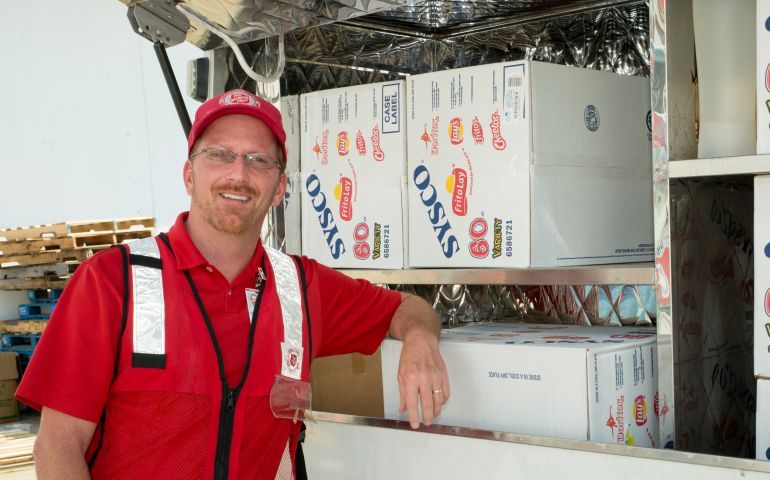The Salvation Army Continues to Serve After Hurricanes Harvey, Irma, Maria
David Jolley | david.jolley@usn.salvationarmy.org | (404) 569-0219

Immediate relief, ongoing recovery efforts in response to catastrophic 2017 Atlantic hurricane season are nonprofit’s largest since Hurricane Katrina
ALEXANDRIA, Va. (August 28, 2018) – The Salvation Army continues to be a source of hope, stability and service to the residents of Texas, Georgia, Florida, Puerto Rico and the U.S. Virgin Islands after the costliest hurricane season in U.S. history. With a presence in every ZIP code in America, The Salvation Army was uniquely positioned to serve survivors and first responders during and immediately after each storm. Today, The Salvation Army remains committed to long-term recovery and rebuilding.
“The relief effort for last year’s hurricane season is unprecedented in size and scope and is likely to last for years,” said Commissioner David Hudson, national commander for The Salvation Army. “Thanks to generous public support, The Salvation Army will continue to serve in local communities for as long as there is need.”
Generous donations of about $125 million were received to support survivors. One hundred percent of the funds are designated for relief and recovery efforts. $34 million was used for immediate response and $91 million has been allocated to long-term recovery care.
Immediate Relief Efforts
During and immediately after the storms, The Salvation Army deployed trained disaster-relief staff and volunteers from the United States, Canada and Mexico to provide food, hydration, cleanup kits, hygiene supplies, and emotional and spiritual care to first responders and survivors. Multiple staging and logistical centers were established throughout the Gulf Coast, southeastern United States, Puerto Rico and St. Thomas.
In response to the 2017 Atlantic hurricane season, The Salvation Army:
- Deployed about 200 mobile feeding units
- Served 2,109,695 meals, 1,536,289 snacks and 3,441,981 drinks
- Provided emotional and spiritual care to 147,286 first responders and survivors
- Provided more than 3.5 million hours of volunteer and employee service
- Distributed 22,006 cleanup kits and 167,816 comfort kits
Long-Term Recovery Care
After disaster response transitioned from immediate relief to long-term recovery care, volunteers and staff started working to restore basic social service programs, while case managers coordinated with local, state and federal entities to implement long-term recovery plans for rebuilding. Because needs vary from community to community, The Salvation Army works hand in hand with local, state and federal partners, to develop sustainable programming for communities to rebuild.
Since April 1, The Salvation Army is one of the few non-governmental organization (NGO) still serving Puerto Rico.
“After disasters large or small, people often rely on The Salvation Army to help them get back on their feet. It’s important to rebuild communities but also help break the cycle of poverty that is so present to disaster survivors,” said Lt. Col. Ward Matthews, national community relations and development secretary. “This is a responsibility we take seriously. It is our mission and our calling.”
A few of the ways The Salvation Army supports long-term recovery care:
- In Texas, in partnership with J.C. Penny, Home Depot, Ashley Furniture, Good360, Rooms To Go and Mattress Firm, The Salvation Army distributes mattresses, building products, furniture, and household goods with no direct cost to survivors in impacted communities.
- In Georgia, caseworkers are supporting long-term recovery efforts in the state’s coastal communities, meeting emergency and long-term recovery needs, supporting the purchase of rebuilding supplies, and helping dialysis and cancer patients evacuated through the National Disaster Medical System mission.
- In Florida, working with recovery organizations providing building assistance in a partnership with The Home Depot to buy building materials for residents in the hardest-hit areas.
- In Puerto Rico, the Houses to Homes project is supplying furniture, appliances and household goods, when structural repair or home remodel is complete. To assist from the U.S. Mainland, the Evacuation Assistance Program provides services to transition to a new life outside of Puerto Rico or return home.
- In the U.S. Virgin Islands, focused on youth resiliency projects and opening Disaster Service Centers in strategic areas where no corps is operating. Long-term recovery efforts will require work beyond normal efforts and additional services to help those in the most critical need.
Responding to catastrophic disasters often takes a significant toll on first responders. The Salvation Army has increased disaster training, invested in equipment and infrastructure, strengthened relationships with local and federal officials, placed a greater emphasis on emotional and spiritual care, and developed more post-deployment follow-up services for disaster workers.
To learn more about how The Salvation Army helps disaster survivors through emergency preparedness, immediate emergency response, long-term disaster recovery, and emotional and spiritual care, visit disaster.salvationarmyusa.org.
About The Salvation ArmyThe Salvation Army annually helps more than 30 million Americans overcome poverty, addiction, and economic hardships through a range of social services. By providing food for the hungry, emergency relief for disaster survivors, rehabilitation for those suffering from drug and alcohol abuse, and clothing and shelter for people in need, The Salvation Army is doing the most good at 7,600 centers of operation around the country. In the first-ever listing of “America’s Favorite Charities” by The Chronicle of Philanthropy, The Salvation Army ranked as the country’s largest privately funded, direct-service nonprofit. For more information, visit www.SalvationArmyUSA.org. Follow us on Twitter @SalvationArmyUS and #DoingTheMostGood.